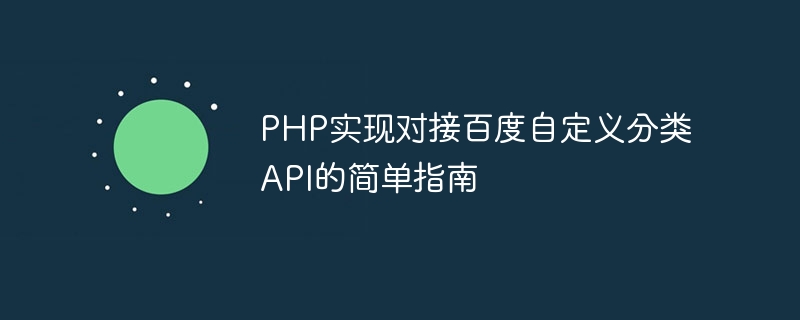Home >Backend Development >PHP Tutorial >A simple guide to implement PHP docking with Baidu's custom classification API
A simple guide to implement PHP docking with Baidu's custom classification API
- WBOYWBOYWBOYWBOYWBOYWBOYWBOYWBOYWBOYWBOYWBOYWBOYWBOriginal
- 2023-08-25 23:24:281368browse

A simple guide to connect PHP to Baidu's custom classification API
Baidu's custom classification API can help developers quickly classify text, images and other data. This article will introduce how to use PHP language to connect to Baidu's custom classification API, and provide code examples for reference.
1. Apply for Baidu Custom Classification API
First, you need to apply for permission to use Baidu Custom Classification API. For the specific application process, you can check the official documentation of Baidu Custom Classification API, so I won’t go into details here.
2. Preparation
Before starting, we need to install the PHP development environment and ensure that the curl extension has been installed and enabled. You can check whether the curl extension has been installed by using the following command:
php -m | grep curl
If curl is returned, the curl extension has been installed and enabled.
3. Write code
We can use the following steps to connect to Baidu’s custom classification API:
- Define the necessary parameters
$access_token = 'YOUR_ACCESS_TOKEN'; // 百度自定义分类API的访问令牌
$url = 'https://aip.baidubce.com/rpc/2.0/unit/service/classify'; // API的请求URL
$method = 'POST'; // 请求方法
$headers = array('Content-Type: application/json'); // 请求头部 Among them, $access_token is the access token we obtained when applying for the API. $url is the request URL of the API, $method is the request method, and the POST method is used here. $headers is the request header information, specifying that the format of the request data is JSON.
- Build request data
$data = array(
'text' => '要分类的文本',
'type' => 'custom', // 表示使用自定义分类
'top_num' => 5 // 返回分类的结果数
);In the above code, $data is an associative array that contains the text to be classified, classification type and return Information such as the number of results.
- Initiate a request
$ch = curl_init(); curl_setopt($ch, CURLOPT_URL, $url); curl_setopt($ch, CURLOPT_HTTPHEADER, $headers); curl_setopt($ch, CURLOPT_POST, true); curl_setopt($ch, CURLOPT_POSTFIELDS, json_encode($data)); curl_setopt($ch, CURLOPT_RETURNTRANSFER, true); $result = curl_exec($ch); curl_close($ch);
The above code uses the curl library to send an HTTP request and save the request result in the $result variable.
- Processing the returned results
$result_array = json_decode($result, true); // 将结果转换为关联数组
if (isset($result_array['error_code'])) {
// 请求发生错误
echo '请求发生错误:' . $result_array['error_msg'];
} else {
// 解析分类结果
$classification = $result_array['results'][0]['name'];
echo '分类结果:' . $classification;
}The above code parses the returned JSON string into an associative array, and determines whether an error has occurred based on the results. If there are no errors, we can get the name of the category by parsing the results.
4. Summary
Through the above steps, we can easily connect to Baidu's custom classification API. Readers can further expand and optimize the code according to their actual needs. At the same time, you can also refer to the official documentation of Baidu's custom classification API to learn more detailed interface parameters and functions.
The sample code here is just a simple demonstration. In actual projects, you may need to add functions such as error handling, logging, and other security measures to ensure the stability and security of the program.
The above is the detailed content of A simple guide to implement PHP docking with Baidu's custom classification API. For more information, please follow other related articles on the PHP Chinese website!
Related articles
See more- PHP uses array_unique to deduplicate two-dimensional arrays
- How to open php file? How to run php file?
- Summary of the advantages and disadvantages of the four major PHP frameworks
- PHP calls Baidu weather interface API to query real-time weather
- PHP uses QueryList to easily implement a Baidu network disk resource search engine

